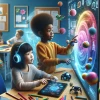
In today's digital age, technology has become an integral part of our lives, reshaping the way we work, communicate, and learn. For parents eager to provide their children with the best educational opportunities, leveraging technology can be a game-changer. However, the challenge lies in using these tools effectively without overwhelming or distracting young learners. This article explores practical strategies and tools to enhance your child’s education using technology, ensuring a balanced and enriched learning experience.
The Digital Classroom: More than Just a Trend
The concept of a digital classroom extends beyond mere access to devices. It encompasses interactive platforms, virtual learning environments, and digital resources that make education more engaging. Tools like Google Classroom and Microsoft Teams have transformed traditional teaching methods, allowing teachers to create a more interactive and inclusive learning atmosphere. For instance, students can now collaborate on projects in real-time, regardless of geographical barriers, fostering a sense of community and teamwork.
Interactive Learning: Making Education Fun and Effective
Interactive learning apps like Kahoot! and Quizlet are revolutionizing the way children engage with educational content. These platforms turn learning into a game, which not only makes the process enjoyable but also enhances retention rates. By incorporating elements of gamification, children are more motivated to engage with the material. Imagine a child eagerly completing math quizzes just to earn points and badges — that's the power of interactive learning.
Personalized Learning Paths: Catering to Individual Needs
One of the significant advantages of technology in education is the ability to tailor learning experiences to individual needs. Platforms like Khan Academy and Duolingo offer personalized learning paths, adapting to the pace and level of each student. This customization ensures that children who need more time with certain subjects can take it, while those who excel can move ahead without waiting. Such personalized approaches can prevent students from feeling either overwhelmed or under-challenged.
Balancing Screen Time: A Challenge for Modern Parents
While technology can be a valuable educational tool, it's crucial to balance screen time to prevent negative impacts on a child's health and well-being. Establishing clear rules about when and how long children can use their devices is essential. Encourage breaks and physical activities to ensure a balanced lifestyle. Tools like Family Link by Google can help parents monitor and manage their children's screen time effectively.
Common Pitfalls: Avoiding Distractions and Over-reliance
A common mistake parents make is allowing technology to become a distraction rather than a tool for learning. It's easy for children to veer off into non-educational content. Setting up parental controls and monitoring usage can help mitigate this risk. Additionally, while technology can enhance education, relying solely on digital tools without incorporating traditional methods can lead to gaps in learning. Striking a balance between digital and traditional educational resources is key.
Encouraging Critical Thinking Through Technology
Technology offers unique opportunities to develop critical thinking skills. Platforms like Minecraft Education Edition encourage problem-solving and creativity. These tools often require students to think critically to progress, fostering a mindset that is valuable in all areas of life. Encouraging children to explore these platforms can help them develop vital skills while having fun.
Collaborative Projects: Building Teamwork Skills
Digital tools facilitate collaboration on projects, even when students are not physically together. By using platforms like Padlet and Trello, students can work together on assignments, share ideas, and provide feedback to each other. This collaboration enhances their teamwork skills, preparing them for future academic and professional environments where such skills are indispensable.
Leveraging Educational Videos and Podcasts
Educational videos and podcasts can be a powerful supplement to traditional learning. Websites like TED-Ed and podcasts tailored for children cover a wide array of topics, making complex subjects more digestible and engaging. These resources can introduce children to new ideas and perspectives, sparking curiosity and a love for lifelong learning.
The Role of Parents: Guiding and Supporting
Parents play a crucial role in guiding their children’s use of technology. By actively participating in their child's digital education, parents can better understand the tools and resources available and help their children navigate them effectively. Engaging with your child about what they are learning and showing interest in their digital activities can foster a supportive learning environment.
Future-Proofing Education with Technology
As technology continues to evolve, so too will the educational tools available to children. Staying informed about the latest advancements and being open to integrating new technologies into your child's education can help prepare them for a future where digital literacy is critical. Encouraging adaptability and a willingness to learn new skills will set the foundation for success in an ever-changing world.































